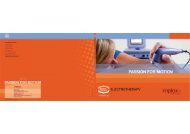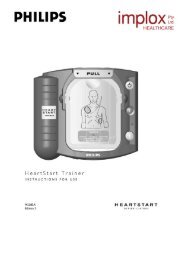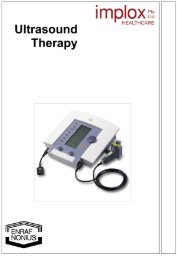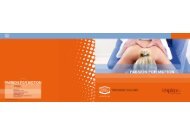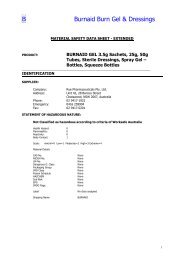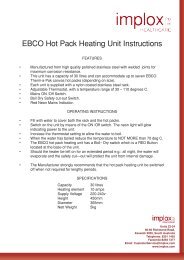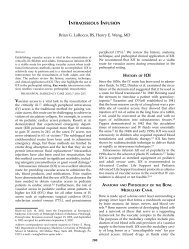CASMED 740 Vital Signs Monitor - Implox
CASMED 740 Vital Signs Monitor - Implox
CASMED 740 Vital Signs Monitor - Implox
You also want an ePaper? Increase the reach of your titles
YUMPU automatically turns print PDFs into web optimized ePapers that Google loves.
<strong>CASMED</strong> <strong>740</strong> <strong>Monitor</strong>s<br />
WARNING:<br />
Do not gas sterilize or autoclave the monitor.<br />
Do not use the monitor in the presence of Magnetic Resonance Imaging (MRI) equipment.<br />
Do not apply the blood pressure cuff on an extremity being used for an intravenous infusion.<br />
Do not place liquids on top of the monitor. Do not immerse the monitor or power cord in water or<br />
any liquid. If unit is accidentally wetted it should be thoroughly dried. The rear cover can be<br />
removed by a qualified service technician to verify absence of water.<br />
During use and testing, single-use disposable temperature probe covers will limit patient crosscontamination<br />
and ensure the safety of the patient, user and device. The use of any other probe<br />
covers or failure to use a probe cover may produce temperature errors and will invalidate the<br />
monitor’s warranty.<br />
A pulse oximeter should be considered an early warning device. As a trend toward patient<br />
deoxygenation is indicated, blood samples should be analyzed by a laboratory co-oximeter to<br />
completely understand the patient’s condition.<br />
Accurate oxygen saturation measurements cannot be obtained when the oximeter is not<br />
measuring the pulse properly. If the perfusion LED is erratic or the Pulse Rate display is erratic<br />
or inaccurate, first examine the patient for any sign of distress and only then re-examine sensor<br />
placement.<br />
ACCURACY – If the accuracy of any measurement does not seem reasonable, first check the<br />
patient’s vital signs by alternate means and then check the <strong>CASMED</strong> <strong>740</strong> <strong>Monitor</strong> for proper<br />
functioning.<br />
CABLES – Route all cables away from patient’s throat to avoid possible strangulation.<br />
DEFIBRILLATION – Do not come in contact with patients during defibrillation. Serious injury or<br />
death could result.<br />
DISPOSAL – Dispose of the packaging material, observing the applicable waste control<br />
regulations.<br />
LEAKAGE CURRENT TEST – The interconnection of auxiliary equipment, including a patient<br />
monitor or other patient equipment, with this device may increase the total leakage current.<br />
When interfacing with other equipment, a test for leakage current must be performed by a<br />
qualified biomedical engineering personnel before using with patients. Serious injury or death<br />
could result if the leakage current exceeds applicable standards.<br />
SITE REQUIREMENTS – For safety reasons, all connectors for patient cables and sensor leads<br />
are designed to prevent inadvertent disconnection, should someone pull on them. Do not route<br />
cables in a way that they may present a stumbling hazard. For devices installed above the<br />
patient, adequate precautions must be taken to prevent them from dropping on the patient.<br />
40<br />
21-02-0298 REV. 00 12/06



